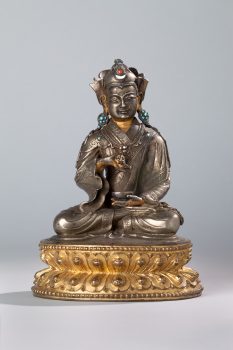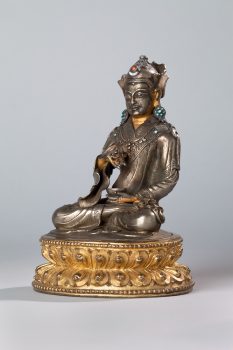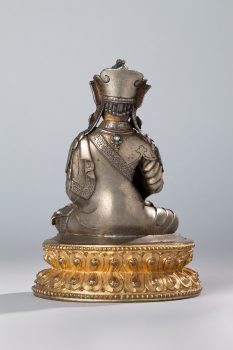Tibet
15th century
Also known as vajra position, this posture is associated with meditation.
Tibet
15th century




Padmasambhava, an Indian teacher said to have been miraculously born inside of a lotus flower—hence his name, which means “lotus-born”—is revered by all schools of Tibetan Buddhism. He is credited with taming the forces adverse to Buddhism in Tibet, including many indigenous gods that he transformed into Buddhist protectors. He is considered one of the founders of Buddhism in Tibet, along with the monastic Shantarakshita and the king Trisong Detsen, and is sometimes revered as the Second Buddha. In his most common representation he can easily be recognized by his peculiar hat and elaborate dress, which combines secular, Tantric, and monastic elements (boots, long sleeves, and outer robe).This marvelous silver sculpture is rich in detail. From the felt collar of the innermost vest to the pointed cape visible only on the right shoulder to the wide flaring sleeves, each element has been finely and thoughtfully executed. Other particularly refined details include the necklace on top of the clothing and the knot-shaped braids on the shoulders. A light sway in the body adds a sense of immediacy to the image, and the inlays, paint, and golden base enliven it. As such this is an example of Tibetan metal craftsmanship at its best.
A religious movement that originated in India around the fifth to seventh century with sacred writings and esoteric teachings and practices transmitted from teacher to student through initiation. These remain an important part of Hinduism and Buddhism today.
A virtuous feeling and deep respect toward an authentic teaching, teacher, or path. Buddhists believe that expansive study, analysis, and meditation are essential steps for cultivating a healthy and enduring devotion.
The transmission of teachings from one generation to the next, from teacher to student, traced all the way back to the Buddha without interruption. A complete lineage is essential in Tantric Buddhist practices as it makes the blessings of the teaching more powerful.
Himalayan art includes portraits of legendary and historical humans, including accomplished religious teachers (lamas), the Buddha’s original disciples (arhats), and spiritually accomplished tantric masters (mahasiddhas).
Today, Tibetans primarily inhabit the Tibetan Plateau, situated between the Himalayan mountain range and the Indian subcontinent to the west, Chinese cultural regions to the east, and Mongolian cultural regions to the northeast. During the 7th to 9th century, Tibetan rulers expanded their empire across Central Asia, and established Buddhism as the state religion.
Get the latest news and stories from the Rubin, plus occasional information on how to support our work.